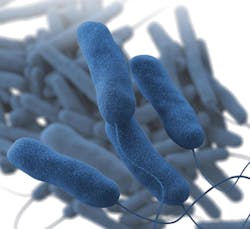Making Advances
A steady rise of Legionnaires’ disease in the U.S. since 2000 has resulted in greater scrutiny of commercial plumbing and HVAC system maintenance and design to reduce instances of the often-fatal disease.
According to the Occupational Safety and Health Administration (OSHA), primary sources of exposure to contaminated water in commercial and industrial facilities are plumbing and HVAC systems—potable water sources such as domestic hot and cold water, as well as cooling towers or fluid coolers. The disease is spread when contaminated water is disseminated through a water system—most often in aerosol form, spray or mist—and manifests as pneumonia in affected individuals.
In its investigation of Legionnaires’ disease outbreaks between 2000 and 2014, the Centers for Disease Control and Prevention (CDC) identified potable water in 56% of the cases as the most frequent source of exposure—it is blamed for 58% of cases in hotels and resorts and 67% of outbreaks in hospitals and long-term care facilities.
Because there are no medical prevention measures for Legionellosis—the name of the disease produced by Legionella bacteria—diligent maintenance of water systems is critical to reducing conditions for bacteria growth. The CDC investigation determined that nearly all of the Legionnaires’ disease outbreaks could have been prevented through more effective water management. Outbreaks traced to potable water sources revealed inadequate water disinfectant levels and water temperatures in optimal ranges for Legionella growth.
A water temperature of 95°F is optimum for Legionella bacteria growth, but bacteria can amplify to an infectious state between temperatures of 68°F and 120°F. The bacteria cannot survive above 130°F.
According to American Society of Plumbing Engineers (ASPE) guidelines, maintaining hot water return temperature above 124°F and distribution system temperature at or above 140°F is recommended for Legionella control. Legionella bacteria exposed to 140°F water will die within 30 minutes. However, higher temperatures pose a scalding risk to people—a three-second exposure to 140°F water can result in a first-degree burn.
Thermostatic balance valves installed at the end of each zone prior to combining with the main return piping can help prevent Legionella bacteria.
Product Advancements
It is for that reason plumbing system design often includes the use of thermostatic balance valves to reduce the risk of scalding.
In large plumbing systems installed in universities, hospitals, hotels and other commercial buildings, domestic hot water recirculating pumps ensure hot water on demand with little to no lag time from the basement boiler, especially during times of peak demand. The pump continually passes hot water through the system and returns it to the heating source to be recirculated, maintaining temperature.
New products, such as Bell & Gossett’s Temp-Setter thermostatic balance valves, have been designed specifically to help prevent Legionella bacteria development in potable water systems. The thermostatic balance valve is installed at the very end of each zone prior to combining with the main return piping. The adjustable temperature-based balance valves allow temperature control between 98°F and 149°F.
When valves are paired with technologically advanced circulator pumps, the constant flow of water helps prevent Legionella growth. “Dead legs” in piping design can lead to scale and biofilm buildup—environments where Legionella can survive and multiply. The Temp-Setter valve has a minimum constant volume of 0.36, to avoid 0-gal-per-minute flow and prevent stagnant water and pump deadheading.
Industry Directives
There are a number of voluntary guidelines to assist engineers in designing domestic hot water heating systems, including American Society of Heating, Refrigerating and Air-Conditioning Engineers (ASHRAE) Standard 188: Legionellosis: Risk Management for Building Water Systems, which establishes minimum Legionellosis risk management requirements for building water systems. For engineers involved in the design of centralized building water systems and components, Section 8 of ASHRAE Standard 188 outlines specific guidelines for designers to follow.
The first step is to determine if the project includes risk factors associated with Legionnaires’ disease, which most often affects the elderly or those with compromised immune systems, such as those in health care facilities and senior housing facilities.
If projects include components that have the potential to release water in an aerosol form—such as domestic plumbing fixtures, cooling towers or evaporative condensers, ornamental fountains, or even ice machines—the system designer must adhere to Section 8 of the standard. Section 8 also requires designers to provide detailed construction documents that include instructions for proper balancing and commissioning of all building water systems, including the procedures for flushing and disinfection.
Hot water recirculating pumps ensure hot water demand has little to no lag in a system, regardless of the origin of the tap calling for it.
Possible Risks
Detailed Legionella mitigation plans for new systems will help avoid future outbreaks. However, ASPE acknowledges that in buildings with older piping systems or municipal codes that restrict hot water temperatures remain roadblocks to eradication of Legionella bacteria.
This is true in the case of some hospitals where older piping systems do not allow for thermostatic mixing valves at all outlets and rules prevent domestic hot water system temperature above 115º to 120ºF to protect patients from scalding. The unfortunate downside is that Legionella bacteria can still thrive at those temperatures, ASPE notes.
Diligent maintenance of systems is OSHA’s recommended protocol to combat Legionella bacteria growth. One such method is to disinfect the piping system by elevating the system temperature to 150ºF or more and flushing the hot water through each outlet. Other methods include ultraviolet radiation, hyper-chlorination and a combination of methods.
Cases of Legionnaires’ disease continue to rise since the 2000 to 2014 CDC study—more than 6,000 cases were reported in 2017, a 15% increase over 2016, according to CDC. In addition, it is difficult to distinguish Legionnaires’ disease from other forms of pneumonia, so many cases are not linked to contaminated water systems—as many as 25,000 cases annually, OSHA estimates. Until such time as Legionnaires’ disease can be eliminated, water system maintenance, thoughtful system design, product research and development remain the most effective weapons.
